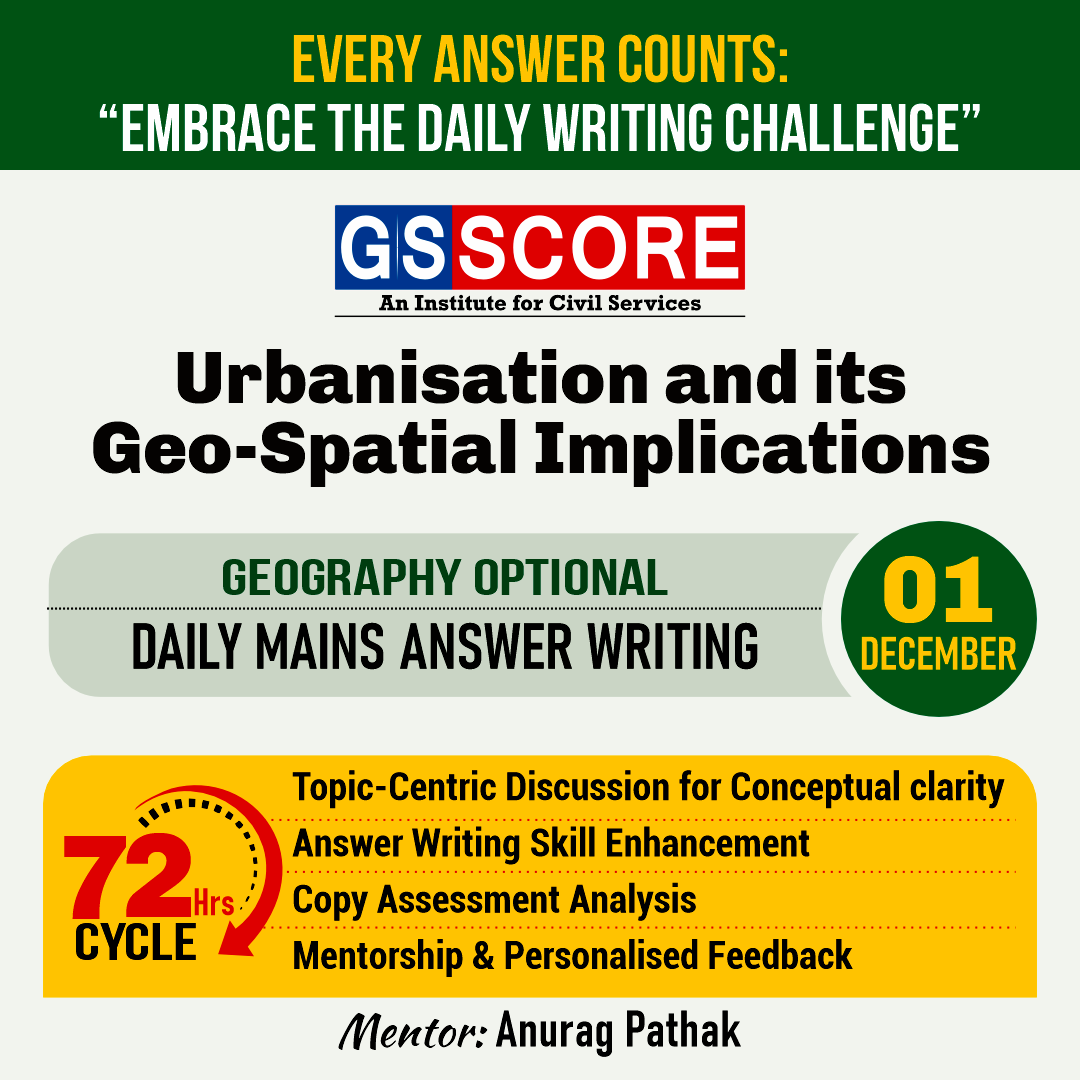


Instruction:
- There will be 2 questions carrying the First Question is-10 marks Write your answers in 150 words and the Second Question is-15 marks Write your answers in 250 words.
- Any page left blank in the answer-book must be crossed out clearly.
- Evaluated Copy will be re-uploaded on the same thread after 2 days of uploading the copy.
- Discussion of the question and one to one answer improvement session of evaluated copies will be conducted through Google Meet with concerned faculty. You will be informed via mail or SMS for the discussion.
Question #1. Evaluate the Challenges of Urban Sprawl in Developing Countries 10 marks (150 words)
Question #2. Analyse the Role of Geo-Spatial Technologies in Urban Planning and Development. 15 marks (250 words)
(Examiner will pay special attention to the candidate's grasp of his/her material, its relevance to the subject chosen, and to his/ her ability to think constructively and to present his/her ideas concisely, logically and effectively).
STEPS & INSTRUCTIONS for uploading the answers
Step 1 - The Question for the day is provided below these instructions. It will be available at 7:00 AM.
Step 2 - Uploading of Answers : Write the answer in A4 Sheet leaving proper margins for comments and feedback and upload the PDF in MY ACCOUNT section. Click on the option of SUBMIT COPY to upload the PDF.
Step 3 - Deadline for Uploading Answers: The students shall upload their answers by 7:00 PM in the evening same day. The first 50 copies will be evaluated.
Step 4 - Feedback : Mentors will give their feedback for the answers uploaded. For more personalised feedback, join our telegram channel by clicking on the link https://t.me/mains_answer_writing_cse . A one-to-one session will be conducted with the faculty after copy evaluation in 72 Hrs.
Model Answer
Question #1. Evaluate the Challenges of Urban Sprawl in Developing Countries 10 marks (150 words)
Ans
The challenges of urban sprawl in developing countries are complex and multifaceted, requiring integrated solutions that consider environmental sustainability, social equity, and economic viability.
- Location and Spatial Organization: Urban sprawl often occurs on the outskirts of cities, where the spatial organization is less structured compared to the urban core. The geography of these areas is characterized by lower density and haphazard development. This sprawl can disrupt the natural landscape, leading to issues like habitat fragmentation and loss of agricultural land.
- Human-Environment Interaction: One of the fundamental principles of geography is the interaction between humans and their environment. In the context of urban sprawl, this interaction is often imbalanced. Rapid and unplanned expansion can lead to significant environmental degradation, including deforestation, loss of biodiversity, and water pollution. Moreover, the increased reliance on automobiles exacerbates air pollution and contributes to climate change.
- Region and Place: Different regions experience urban sprawl differently, influenced by their unique geographic, socio-economic, and cultural contexts. In developing countries, urban sprawl can often occur without adequate planning or infrastructure, leading to the development of informal settlements or slums. These areas, while providing essential housing, often lack basic services such as clean water, sanitation, and safe roads.
- Physical Geography and Natural Resources: The physical geography of an area greatly influences the pattern and impact of urban sprawl. For instance, sprawl in coastal regions or floodplains can increase vulnerability to natural disasters. Moreover, the unsustainable use of natural resources in rapidly expanding urban areas can lead to resource depletion and environmental degradation.
- Movement and Accessibility: Geographical principles also emphasize the importance of movement and accessibility. Urban sprawl typically leads to increased travel distances and reliance on personal vehicles, contributing to traffic congestion and reduced air quality. In developing countries, where public transportation may be limited, this can have significant implications for mobility and access to employment and services.
- Scale: The challenge of urban sprawl must be understood at different scales - from local to global. Locally, sprawl affects city planning and resource distribution. Regionally, it impacts environmental systems and socio-economic dynamics. Globally, the implications extend to climate change and international migration trends.
- Sustainability and Resilience: Finally, urban sprawl poses significant challenges to sustainability and resilience, key geographical concepts. The spread of low-density, auto-dependent development is often at odds with sustainable land use and resource management. Moreover, sprawling urban areas may lack the resilience to cope with environmental and socio-economic shocks.
Question #2. Analyse the Role of Geo-Spatial Technologies in Urban Planning and Development. 15 marks (250 words)
Ans
Geo-spatial technologies are invaluable tools in urban planning and development. They offer comprehensive insights into spatial patterns, facilitate informed decision-making, enhance environmental sustainability, and contribute to building resilient and inclusive urban environments.
- Spatial Analysis and Location Intelligence: One of the core principles of geography is the significance of location. Geo-spatial technologies enable detailed spatial analysis, allowing urban planners to understand and visualise the spatial distribution of various urban elements like housing, infrastructure, green spaces, and commercial areas. This location intelligence is crucial for effective urban planning and decision-making.
- Land Use and Land Cover Change Analysis: Geo-spatial technologies facilitate the monitoring and analysis of land use and land cover changes over time. This is essential in urban planning to understand urban sprawl, assess the impacts of urbanisation on natural environments, and plan for sustainable land use patterns.
- Human-Environment Interaction: Urban planning is fundamentally about managing the interaction between humans and their environment. Geospatial technologies help in assessing the environmental impacts of urban development, such as changes in green spaces, urban heat islands, and the encroachment on natural habitats. This enables planners to develop strategies that minimise negative environmental impacts.
- Integration of Scale: Geography emphasises the importance of scale, and geo-spatial technologies allow for the analysis of urban issues at various scales - from local neighbourhoods to entire metropolitan areas. This scalability is vital for addressing both detailed local planning issues and broader regional development strategies.
- Disaster Management and Resilience Building: Geo-spatial technologies play a critical role in urban resilience and disaster management. They are used for risk assessment, identifying vulnerable areas, planning evacuation routes, and coordinating disaster response. This aligns with the geographical principle of understanding and managing risk in human-environment systems.
- Infrastructure Planning and Management: The planning and management of urban infrastructure, such as transportation networks, water supply, and sewage systems, benefit greatly from geo-spatial technologies. These tools help in optimising routes, managing assets, and planning for future infrastructure needs based on demographic and spatial data.
- Public Participation and Inclusivity: Modern geo-spatial technologies support participatory urban planning approaches. Web-based GIS and mapping tools allow for greater public involvement in the planning process, ensuring that diverse perspectives are considered, which is crucial for inclusive and equitable urban development.
- Data-Driven Decision Making: The ability to gather, analyze, and visualise large datasets is a fundamental advantage of geo-spatial technologies. This data-driven approach aids urban planners and policymakers in making informed decisions, grounded in empirical evidence.

